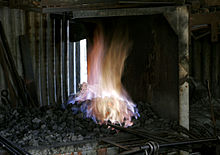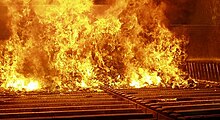Grate firing
The grate is a solid firing in which the fuel is located on a grate and burns. The grate is a surface with openings. The openings in the grate serve to supply the for the combustion necessary air ( "Under wind") and the discharge of the residual ashes . The necessary movements to circulate (" stir up ") the fire and to remove the ashes are carried out manually with a poker for simple grate firings , and automatically by moving the grate for larger grate firings .
history
Grate firing is one of the oldest types of firing. It represents an improved variant of the basic shape of the fireplace, as it has been used by man since the Stone Age: In an open fire such as the campfire , solid fuel is also burned lying on a support surface , however, this pad had no openings; the air is supplied from the side and the ashes remained in the fire.
The main further development compared to this basic shape was to provide the support surface with openings through which the combustion air could flow in from below and the ashes could fall through. This increased the efficiency of the furnace and the air supply became more even, the amount of air could be controlled by flaps and it was easier to "stoke" the fire.
Up until the 19th century, grate firing with static grate (see section "Grate types") was the only type of firing available. The job of the stoker was to feed the furnace with fuel, to stir it up and to adapt it to the heat demand. He was able to influence the fuel loading and the distribution of the fuel on the grate and the amount of combustion air by adjusting throttle valves. In the case of steam locomotive boilers, there is also the option of increasing the induced draft with a blow pipe . The stoker had to constantly watch the furnace, add fuel, distribute the fuel on the grate and poke around to remove the ashes.
Grate firing was further developed in the 20th century: fuel supply, forward movement, stoking and ash removal were automated and are carried out continuously with modern grate firing in industry and power plants, as is the regulation of the combustion air.
Structure and function of an industrial grate furnace
With a modern, larger grate furnace, as it is used today in industry and heating / power plants , the fuel is fed to the grate automatically and continuously, e.g. B. by means of screw conveyors, mechanical slides or double flaps. At the same time, these conveyors provide a seal to the fuel storage container and prevent burn-back.
The fuel is continuously conveyed by a movement mechanism (for the various types of which, see section "Grate types") from the entry to the ash discharge and automatically circulated ("stoked"). In the first area of the grate, the fuel is dried and degassed . This is followed by the main combustion zone, and burnout takes place in the last grate section.
The openings in the grate are called the free grate surface . The primary combustion air reaches the fuel from below through these grate openings ("underwind"). Large grids are divided into zones, each with a separate underwind feed, so that the air volume can be set independently of one another by throttle valves in the individual zones. In addition, secondary air is released above the grate. The combustion air ratio λ is 1.4 to 1.8. It is important to distribute the fuel evenly on the grate in order to avoid uneven combustion with locally strong air penetration. Too much grate loading must be avoided, as it would hinder the air supply and incomplete combustion with the formation of carbon monoxide would occur. In extreme cases, there is a risk of deflagration .
The drying of moist fuels (biomass, household waste, ...) can be supported by preheated primary air, or exhaust gases from the exhaust gas path are added to the primary air. This admixture is called flue gas recirculation and also serves as a measure to reduce nitrogen oxide in the area of high flame peak temperatures (especially for fuels with high calorific values). In larger systems, part of the exhaust gases is also added above the grate. Similar to the secondary air nozzles, so-called recirculation nozzle levels are used.
Depending on the type of furnace, the flue gas outlet is located above the degassing zone (counter-current furnace), in the middle of the grate (medium-flow furnace) or at the end of the grate (co-current furnace). In the case of particularly wet fuels, the hot flue gases are preferably directed in countercurrent to the movement of the fuel on the grate, thus achieving intensive drying and degassing of the fuel. The air is supplied as primary air below the step grate and as secondary air above the grate.
Most of the ash produced during incineration falls as coarse, sintered slag at the end of the grate through the so-called "ash fall" and is collected in the ash pan or continuously discharged via a ash removal device. Finer ash components also fall into the ashtray / ash pan on the way through the free grate surface. To cool the ashes and to extinguish the embers, this is usually designed as a water bath, which also provides the air seal for the underpressure furnace.
The grate is exposed to strong thermal loads, the operating temperatures on the surface can be up to 800 ° C (see fire cast ). The combustion air passing through cools the grate. Water-cooled grids can be used for very high calorific values. The combustion chamber is always lined with a fireproof lining, because the temperature in the fire is around 1000 ° C.
Advantages and disadvantages
Compared to dust firing (combustion in flight), grate firing has some important advantages and disadvantages:
Advantages:
- Simple, clear structure
- Favorable partial load and load change procedure
- Wide permissible fuel range and fuel combination options
- Low own energy requirement
Disadvantage:
- Output limitation due to the grate construction
- Slow controllability due to the large amount of fuel on the grate
- High excess of air , resulting in poorer efficiency
- High combustion loss of 2–4%
Grate types
The different grate types differ fundamentally in the type of mechanism that causes the fuel to move:
Flat grate
In this simplest and oldest form of grate (see section "History"), the grate is immobile and level. The ashes fall into the ash pan under the grate. There is no automatic stoking, but must - if necessary - be done manually by means of a poker , shaking, or the like. The ash removal must also be done manually.
This type is no longer used in larger industrial furnaces today, but it is used in smaller furnaces in the domestic and small commercial sector: fireplace / stove / room stove , grill , wood heating, etc.
Traveling grate
The traveling grate consists of an endless grate belt with movable links, similar to a conveyor belt . The endless belt is guided over 2 rollers and moved with a gear drive .
The speed of the grate advance is adjustable and is used to regulate the output. The grate bars (chain links) are movable. A support surface holds the bars of the upper belt in the horizontal position. When the grate is returned, the bars stand in the vertical position so that the ashes can fall through ( folding grate ). The fuel feed is limited by a layer height regulator. The air chambers for the downwind are arranged between the upper and lower belt. The grate size is limited because of the bending forces acting on the grate bars. The maximum grate area for underwind zones is 70 m².
The traveling grate was a type of construction that was often used to burn lumpy fuel with a low proportion of fine grains. It is suitable for both gas-rich and dry coal and wood as wood chips. Traveling grate firing was widespread in medium-sized power plants (up to 150 t / h steam) from the 1930s to 1960s. Nowadays this type of construction is only used for biomass firing. Today coal is mainly burned in dust and fluidized bed furnaces .
Step grate / bulk grate (moving / return grate)

A step grate / bulk grate looks similar to a flat staircase with a gradient of 8 to 15 degrees. The fuel is moved over the grate by a few steps (every second or two out of three) oscillating back and forth, pushing the fuel forward. Depending on the direction of the grate bar movement , the step grate is also called the moving grate or the backward sliding grate (in both cases, however, there is a forward movement for the fuel).
Stair gratings are used for lumpy and ash-rich fuels that require improved stoking, e.g. B. wood , processed rubbish or now less often brown coal .
Roller grate
In the case of a roller grate, the grate surface consists of large, one behind the other, rotating drum drums, some of which are equipped with drivers and which entrain the fuel through their rotation. This achieves a particularly strong circulation and stoking of the fire. The firing is optimized to save energy thanks to special patented roller grate seals between the rollers.
This type of grate is mainly used in waste incineration for very problematic, unprocessed, inhomogeneous fuel mixtures that have a massive tendency to stick or slag.
Underfeed
With an underfeed firing, a screw conveyor pushes the fuel (e.g. wood pellets) from below onto an annular burner plate. The material burns on the burner plate, whereby the ash is pushed outwards and later falls from the burner plate into the ash chamber.
literature
Fritz Mayr: Kesselbetriebstechnik , 10th edition 2003, ISBN 3-930039-13-3 .



